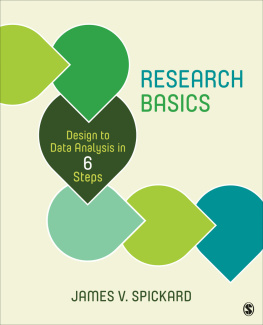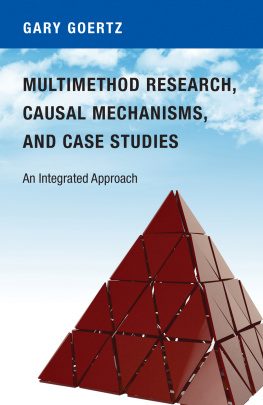Franklin - Design and Analysis of Single-Case Research.
Here you can read online Franklin - Design and Analysis of Single-Case Research. full text of the book (entire story) in english for free. Download pdf and epub, get meaning, cover and reviews about this ebook. year: 2014, publisher: Psychology Press, genre: Romance novel. Description of the work, (preface) as well as reviews are available. Best literature library LitArk.com created for fans of good reading and offers a wide selection of genres:
Romance novel
Science fiction
Adventure
Detective
Science
History
Home and family
Prose
Art
Politics
Computer
Non-fiction
Religion
Business
Children
Humor
Choose a favorite category and find really read worthwhile books. Enjoy immersion in the world of imagination, feel the emotions of the characters or learn something new for yourself, make an fascinating discovery.
- Book:Design and Analysis of Single-Case Research.
- Author:
- Publisher:Psychology Press
- Genre:
- Year:2014
- Rating:3 / 5
- Favourites:Add to favourites
- Your mark:
- 60
- 1
- 2
- 3
- 4
- 5
Design and Analysis of Single-Case Research.: summary, description and annotation
We offer to read an annotation, description, summary or preface (depends on what the author of the book "Design and Analysis of Single-Case Research." wrote himself). If you haven't found the necessary information about the book — write in the comments, we will try to find it.
Design and Analysis of Single-Case Research. — read online for free the complete book (whole text) full work
Below is the text of the book, divided by pages. System saving the place of the last page read, allows you to conveniently read the book "Design and Analysis of Single-Case Research." online for free, without having to search again every time where you left off. Put a bookmark, and you can go to the page where you finished reading at any time.
Font size:
Interval:
Bookmark:

Design and Analysis of Single-Case Research

Edited by
Ronald D. Franklin
The Child Development Center,
St. Mary's Hospital
David B. Allison
New York Obesity Research Center,
Columbia University College of Physicians and Surgeons
Bernard S. Gorman
Nassau Community College/SUNY and Hofstra University

First Published 1996 by Lawrence Erlbaum Associates, Inc.
This edition published 2014 by Psychology Press
711 Third Avenue, New York, NY 10017
and by Psychology Press
27 Church Road, Hove, East Sussex BN3 2FA
Psychology Press is an imprint of the Taylor & Francis Group, an informa business
Copyright 1996 by Lawrence Erlbaum Associates, Inc.
All rights reserved. No part of this book may be reprinted or reproduced or utilised in any form or by any electronic, mechanical, or other means, now known or hereafter invented, including photocopying and recording, or in any information storage or retrieval system, without permission in writing from the publishers.
Trademark notice: Product or corporate names may be trademarks or registered trademarks, and are used only for identification and explanation without intent to infringe.
Cover design by Jessica LaPlaca
Library of Congress Cataloging-in-Publication-Data
Design and analysis of single-case research /edited by Ronald D. Franklin, David B. Allison, and Bernard S. Gorman.
p. cm.
Includes bibliographical references and index.
ISBN 978-0-805-81618-1 (cloth: alk. paper). ISBN 978-0-805-81619-8 (pbk.: alk. paper)
1. PsychologyResearchMethodology. 2. Case Method. 3. Psychometrics. I. Franklin, Ronald D. II. Allison, David B. III. Gorman, Bernard S.
BF76.5.D38 1996
150'722dc20
96-5883
CIP
Publisher's Note
The publisher has gone to great lengths to ensure the quality of this reprint but points out that some imperfections in the original may be apparent.
ISBN-13: 978-1-315-80640-2
Franklin, Allison, & Gorman |
Ittenbach and Lawhead |
Primavera, Allison, & Alfonso |
Gresham |
Franklin, Gorman, Beasley, & Allison |
Gorman and Allison |
Matyas and Greenwood |
Faith, Allison, & Gorman |
Beasley, Allison, & Gorman |
Allison, Silverstein, & Gorman |
A few years ago, at a meeting of the American Psychological Association (August, 1993), I was asked to be the discussant for a series of papers on new research designs for the analysis of single subject data. Some of these papers now appear as chapters in this book. For me, this was an unusual request for two reasons. First, I am a terrible discussant, often drifting far afield from the main topic of the papers at hand. Second, most of my previous research has centered on latent variable structural equation modeling of cognitive abilities using large population based sample (McArdle, 1994). However, as these presenters soon found out, I also advocate the use of more basic models using single subjects. This apparent contradiction on my part requires some further explanation.
The statistical features of the "law of large numbers" are well-known to the contemporary psychologists. In my first college level stats class (circa 1969), I learned the dictum, "odd things happen more often in small samples." Even though this principle is often misunderstood (see Nisbett, 1983), I was sure psychologists were mainly concerned with finding reliable and replicable results, so this was essential knowledge. In later classes on experimental design I learned that the surest way to achieve significant results was to have a very large sample (N); I think this early training accounts for much of my behavior today.
But then I went to graduate school (circa 1973), and things became more complicated. In my very first class I learned that some people had actually written papers on the benefits of what they called N = 1 designs. I was outspoken at this statistical heresy and I paid the price: I was forced (by Dr. Harold Yuker) to read and write about papers by Dukes (1965) and Shapiro (1964), a really difficult article by Rozeboom (1971), and something fairly new by Gottman (1973). I became aware of the importance of the "idiographic versus nomothetic" approaches to construct validation, and I began to understand the central concerns of "generalization" (Cronbach et al., 1972). Although I was respectful of clinical practice, I thought that people were so different from one another that no scientifically useful fact could be found using only one person. I scoffed at this research, took the vows of a different psychologist, and I denied my prior training in experimental psychology. But to be honest, I was pretty young and confused by all this methodological epistemology talk. Secretly, I vowed never to be so cocky about statistics again.
Like all good resolutions, this one passed quickly. In my postgraduate years (1977-1980) I learned to accept my internal conflicts by studying multivariate time series analysis. This was a decidedly eclectic combination of Cattell (1952), Anderson (1963), Lilly (1975), Hibbs (1977), and Huber (1977). After reading about Haldane's (1929) personal breathing experiments, I, like many before me, rushed to start making a statistical analysis of my own behaviors. I tried to take my own cognitive and mood measurements on a daily basis, using my new Apple and a program (PSYLOG) made expressly for me by a computer wiz friend of mine (Boker & McArdle, 1995). This proved to be way too time consuming for me, although I did try to make daily measurements on my wife and child (this lasted for only one weekend before they both stopped speaking to me).
My personal attempts to search for meaning in measurement were not a complete loss because they did alert me to what I now view as a critical statistical misunderstandingthe N in statistical data analysis is not the number of persons but the density of observations. The N we use can refer to the number of variables, the number of occasions, or any set of replicate samples from the larger data box (see Cattell, 1966). The law of large numbers suggests we collect a large number of data points, and especially some kind of replicates, but this does not always refer to subjects. Of course, as in any good experimental design, many levels of replication are important here, including the measurement of multiple occasions, multiple variables, and multiple experimental interventions (Nesselroade & Jones, 1991). I was hooked on this "radical" way of thinking and, as I confess here, I even carried out a multivariate structural modeling analysis of a single subject (McArdle, 1982; reported in Nesselroade & McArdle, 1985).
But enough about me, let me turn briefly to the good work of this book.
This book is about one important aspect of psychological researchthe intensive study of people measured one (or more) at a time. Some important historical material is detailed in several chapters here, and this makes a strong connection to previous works in psychology. The authors of several chapters here present important details on classical and novel methods to study behavior over time, and they do so in the context of appropriate statistical methods. This appropriately reflects the growing interest in examining dynamic behaviors by objective behaviors by objective measurement. Key experimental design principles are expertly stated by these authors. This reflects the growing interest in studying the individual course of development for invariants in behaviors, including some unusual constructs (e.g., cycles, punctuated equilibria, etc.). This book also deals with practical contemporary problems in psychology. The increased possibility of using clinical research tools is well documented here. As you read this book I am sure you will be tempted to try some of these procedures out for yourself. In sum, this book is filled with interesting historical points, informative mathematical and statistical analyses, and practical methods.
Font size:
Interval:
Bookmark:
Similar books «Design and Analysis of Single-Case Research.»
Look at similar books to Design and Analysis of Single-Case Research.. We have selected literature similar in name and meaning in the hope of providing readers with more options to find new, interesting, not yet read works.
Discussion, reviews of the book Design and Analysis of Single-Case Research. and just readers' own opinions. Leave your comments, write what you think about the work, its meaning or the main characters. Specify what exactly you liked and what you didn't like, and why you think so.














